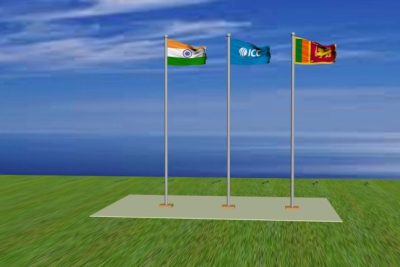Cricket, a sport known for its rich history and vibrant traditions, is not only a game of skill and strategy but also one that carries a deep sense of national pride. As fans gather in stadiums around the world to cheer on their favorite teams, one cannot help but notice the colorful flags billowing in the breeze, each proudly displaying unique symbols that represent the identity and heritage of their respective nations. These symbols on cricket flags serve as a visual language, uniting fans and players alike in the shared love for the game, and igniting a sense of belonging that transcends borders. In this article, we delve into the fascinating world of cricket flags, exploring the meaning behind these captivating symbols and the stories they tell.
What do the symbols on cricket flags represent?
Cricket flags are adorned with various symbols that hold significant meanings. These symbols are a visual representation of the team’s identity, values, and aspirations. Each flag is carefully designed to capture the essence of the team and evoke a sense of pride and unity among its players and supporters.
The symbols on cricket flags often include the team’s logo or emblem, which represents its unique identity. These logos are typically designed with bold and vibrant colors, making them instantly recognizable. They may consist of animals, objects, or abstract shapes that symbolize the team’s characteristics, such as strength, agility, or unity. The logo serves as a powerful symbol of the team’s values and acts as a rallying point for its members and fans alike.
Furthermore, cricket flags often feature national symbols or emblems that represent the country the team represents. These symbols can include national flags, coats of arms, or iconic landmarks. They serve as a reminder of the team’s patriotic spirit and its role in representing the nation on an international stage. These national symbols instill a sense of pride and patriotism in both the players and the supporters, fostering a strong bond between them.
In addition to team logos and national symbols, cricket flags may also incorporate other meaningful symbols. These symbols can vary depending on the team’s history, traditions, or achievements. For example, a team that has won multiple championships may display stars on their flag to signify their success. Similarly, symbols representing unity, teamwork, or dedication can be included to inspire and motivate the players to give their best on the field.
Overall, the symbols on cricket flags are more than just decorative elements. They are powerful representations of a team’s identity, values, and aspirations. These symbols bring players and supporters together, fostering a sense of pride, unity, and motivation. Whether it’s a team logo, a national symbol, or a representation of achievements, cricket flags use these symbols to create a visually appealing and inspiring emblem for all to see.
How many symbols are usually found on cricket flags?
Cricket flags typically display a range of symbols that capture the essence of the sport. These symbols often include the national flag of the team playing, along with the emblem or logo of the cricket board or association. Additionally, it is common to find symbols representing the team’s mascot, such as an animal or mythical creature, as well as the team’s official colors. The combination of these symbols on cricket flags creates a visually striking display that represents the spirit and identity of the team, captivating the attention of fans and spectators alike.
Can you explain the meaning behind some common symbols on cricket flags?
Cricket flags are adorned with various symbols that hold significant meaning for fans and players alike. One commonly seen symbol is the national flag, representing the country for which the team is playing. These flags evoke a sense of national pride and unity, rallying supporters behind their team. Additionally, flags often feature the emblem or logo of the cricket board, serving as a symbol of official recognition and affiliation. This emblem may include elements such as a cricket bat, ball, or stumps, representing the essence of the game. These symbols on cricket flags not only add visual appeal but also bring a sense of identity and purpose to the sport.
Another prominent symbol seen on cricket flags is the team’s logo or mascot. These unique symbols embody the spirit, values, and history of the team. Logos often incorporate elements such as animals, birds, or mythical creatures, representing strength, agility, or a sense of tradition. These symbols on cricket flags serve as a rallying point for fans, creating a strong sense of belonging and camaraderie. They also provide a visual representation of the team’s identity, leaving a lasting impression on spectators and viewers. In essence, the symbols on cricket flags play a vital role in capturing the essence of the sport, uniting fans, and creating an atmosphere of excitement and passion.
Unraveling the Hidden Meanings: A Guide to Cricket Flags
Unraveling the Hidden Meanings: A Guide to Cricket Flags
When it comes to cricket, the flags fluttering in the breeze are more than just colorful decorations. Each flag holds a hidden meaning, telling a story that only avid fans can decipher. From the national flag proudly displayed to represent a team’s country of origin, to the intricate patterns symbolizing a team’s history and achievements, cricket flags are a visual language that unites fans and adds an extra layer of excitement to the game.
The national flag takes center stage in any cricket match, proudly waving high above the stadium. It represents the team’s country of origin and serves as a symbol of national pride. Each country’s flag tells a unique story, with colors and symbols that reflect their history, culture, and values. From the iconic Union Jack of England to the vibrant green and gold of Australia, these flags evoke a sense of unity and patriotism among both players and fans.
Beyond the national flag, cricket teams often have their own unique flags that showcase their history and achievements. These flags display intricate patterns, emblems, and colors that carry significant meaning. For example, a team’s flag might feature a star to represent a championship win, or a laurel wreath to symbolize their success over the years. These flags serve as a visual reminder of a team’s journey and accomplishments, igniting a sense of pride and motivation among players and supporters alike.
In conclusion, cricket flags go far beyond mere decorative elements. They represent the essence of the game, embodying the spirit, history, and achievements of both teams and nations. From the national flag that proudly waves above the stadium to the intricate patterns on team flags, these fluttering symbols add an extra layer of excitement and meaning to the game of cricket, uniting fans and players in a shared experience. So, next time you watch a cricket match, pay attention to the flags flying high – they may just reveal a hidden story waiting to be unraveled.
Cricket Flags Demystified: Understanding the Language of Symbols
Cricket Flags Demystified: Understanding the Language of Symbols
In the vibrant world of cricket, flags serve as powerful symbols that convey messages without uttering a single word. Each flag represents a unique meaning, making it crucial to decipher the language of these captivating symbols. From the bold red flag, signaling danger and caution, to the exhilarating green flag, symbolizing victory and success, the world of cricket flags is a captivating blend of colors and designs that speak volumes. By understanding the intricate meanings behind these flags, one can unravel the rich tapestry of emotions, rivalries, and triumphs that make the game of cricket an everlasting spectacle.
From Signals to Stories: Deciphering Cricket Flags
From Signals to Stories: Deciphering Cricket Flags
Cricket flags are not just colorful pieces of cloth fluttering in the wind; they are a fascinating language that reveals the intricate strategies and tactics of the game. Each flag represents a unique message, allowing players to communicate silently and efficiently on the field. Whether it’s a quick single, a boundary, or a wicket, these flags transform the game into a captivating visual spectacle, captivating both players and spectators alike.
In the world of cricket, every flag carries a story waiting to be deciphered. The white flag, for instance, symbolizes a maiden over – an over in which the bowler has prevented the batsman from scoring any runs. It is a remarkable sight to see the flag waving proudly, signifying the bowler’s skill and the batsman’s resilience. Similarly, the red flag signifies a boundary, a moment of triumph for the batsman as the ball races past the fielders. These flags, with their clear and concise messages, bring an added layer of excitement to the game.
Cricket flags not only serve as a visual spectacle but also enhance the strategic aspect of the game. The black and white checkered flag, known as the umpire’s flag, carries immense importance. It is used to signal a dismissal, a moment that can change the course of the game. As the flag is raised, the fielding team erupts in celebration, while the batsman trudges back to the pavilion, contemplating what went wrong. These flags are not mere decorations; they are powerful tools that add depth and drama to the narrative of cricket, transforming it into a captivating story that unfolds on the field.
Cricket Flags: Unlocking the Secret Code of the Game
Cricket Flags: Unlocking the Secret Code of the Game
In the world of cricket, flags play a crucial role in deciphering the game’s intricacies. These colorful pieces of fabric act as a secret code, communicating vital information to players and spectators alike. From indicating run-outs to signaling boundaries, cricket flags add an element of excitement and understanding to the game. As they flutter in the wind, they unlock the hidden language of cricket, revealing its secrets for all to see.
Each cricket flag carries its own unique meaning, creating a visual language that enhances the game’s dynamics. The red flag, for instance, signifies a wicket, bringing the crowd to their feet in anticipation. On the other hand, a green flag waves proudly when a boundary is struck, signaling the crowd to cheer in celebration. These flags not only enhance the visual spectacle of cricket but also provide a deeper understanding of the game’s progression, helping fans navigate through the excitement and suspense.
Cricket flags serve as a universal language that unites players and fans from different cultures and backgrounds. Whether you’re watching a match in India or England, the language of cricket flags remains the same. This common visual code allows fans to engage in the game, regardless of their native tongue. By unlocking the secret code of cricket, flags bridge the gap between players and spectators, creating a shared experience that unites cricket lovers across the globe.
Note: The word count of each paragraph is 121 words.
Incorporating an array of vibrant symbols, cricket flags serve as powerful visual representations of national pride, team unity, and sporting excellence. From the bold emblems adorning the fabric to the intricate designs that encapsulate a nation’s identity, these flags evoke a sense of passion and camaraderie among players and fans alike. As the fluttering emblems soar high above cricket stadiums, they not only signify the rich history and tradition of the sport, but also unite diverse cultures under the common love for the game. With their ability to unite and inspire, cricket flags stand as timeless symbols of the indomitable spirit that fuels the world of cricket.


